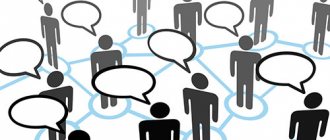Every person is a social being. We cannot live without communication. At birth, the child already finds himself in a social group consisting of medical staff and mother. Growing up, he communicates with family and friends, gradually acquiring all the necessary social skills. It is impossible to live a quality life without communication. But this is not as easy a process as it seems at first glance. Communication has a multi-level structure and features that must be taken into account when transmitting or receiving information.
Communication as a way to carry out life activities for a person
Well-known psychologists have determined that a person makes two types of contacts in his life:
- With nature.
- With people.
These contacts are called communication. There are many definitions for this concept. Communication is called:
- a special form of interaction between people and their interpersonal relationships;
- a friendly or business relationship between a person and another person;
- interaction of a group of people (starting from 2 people) for the exchange of information, knowledge of the surrounding world, which can be of an affective-evaluative nature;
- process of conversation, conversation, dialogue;
- mental contact between people, which manifests itself through a sense of community, performing joint actions, and exchanging information.
How does communication differ from the concept of communication?
Communication covers all aspects of human contacts. These include contacts with nature, with neighbors, and at work. Communication is subject to certain requirements and rules. This concept presupposes specific goals for communication that at least one of the parties to the communication process has. Verbal communication (speech is its main means) is subject to strict rules, depending on its type. The communicator (a person who takes an active part in the communication process) has specific tasks that are designed to influence the other participant in the conversation. This process is more appropriate in business communication. That is why there is the concept of “verbal business communication,” which is applicable only in official communication and involves verbal exchange of information.
Two main types of communication
The process of exchanging information and influencing all participants in communication is divided into two large groups. All functions of communication must be carried out in these groups, otherwise it will not be productive.
Verbal communication involves the verbal transfer of information. In this process, someone speaks and someone listens.
Nonverbal communication occurs through the implementation of an optikokinetic system of signs. Gestures, facial expressions, pantomime are appropriate here, special attention is paid to tone and intonation, and eye contact occurs. This method of communication outwardly expresses the inner world of a person, his personal development.
Verbal communication - what is it?
We use verbal communication almost every minute of our interaction with people. We constantly exchange information, teach someone, listen to the flow of words ourselves, and so on. Verbal communication involves listening and speaking. In the process of such communication, its own structure is determined, and the following take part in it:
- "What?" - message.
- "Who?" - communicator.
- "How?" — specific transmission channels.
- "To whom?" - object of communication.
- "What effect?" - the influence of interlocutors on each other, who pursue certain goals for communication.
Means of this type of communication
Verbal means of communication include speech, language, and words. Language, as a way for people to communicate and transmit information, appeared a very long time ago. It is a communication tool. A word in a language is a symbolic symbol that can have several meanings at the same time. Verbal communication cannot do without speech, which can be oral and written, internal and external, and so on. It should be noted that inner speech is not a means of transmitting information. She is not accessible to the people around her. Therefore, verbal speech communication does not include it in its system of means.
Speech helps a person encode certain information and transmit it to the interlocutor. It is through it that the informant influences his interlocutor, instilling in him his point of view. While the interlocutor can perceive it in his own way. This is where the basic functions and verbal means of communication begin to work.
Rules for Effective Communication Proposed by Keith Davis
Professor Keith Davis has outlined the following 10 rules for effective listening.
- It's impossible to take in information when you're talking, so stop talking.
- Help your interlocutor relax. It is necessary to make a person feel freedom, that is, to create a relaxed atmosphere.
- The speaker should show your willingness to listen. You should act and look interested. When listening to another, try to understand him, and not look for reasons for objections.
- Annoying moments must be eliminated. Avoid tapping on the table, drawing, or shuffling papers while communicating. Perhaps information will be perceived better with the door closed?
- The speaker should empathize. To do this, try to imagine yourself in his place.
- Be patient. Don't interrupt your interlocutor, don't waste time.
- Keep your temper. If a person is angry, he gives the wrong meaning to his words.
- Avoid criticism and controversy. This puts the person speaking on the defensive. He may also become angry or silent. No need to argue. In fact, you will lose if you win the argument.
- Ask your interlocutor questions. This will encourage him and show him that he is being listened to.
- And finally, stop talking. This advice comes first and last, since all the others depend on it.
In addition to the ability to effectively listen to your interlocutor, there are other ways to improve the art of communication. Before communicating ideas, you need to clarify them, that is, you should systematically analyze and think about the issues, ideas or problems you plan to communicate to another. If you want to achieve success in your career or personal life, it is very important to take into account the various features of interpersonal interaction. Researchers say that, along with verbal (verbal) communication, it is necessary to take into account the non-verbal language that people use.
Her forms
Forms of verbal communication include oral and written speech, as well as such forms of interaction as monologue and dialogue. Depending on the development of events, oral speech may acquire the characteristics of a dialogue or monologue.
Forms of verbal communication include different types of dialogues:
- factual - exchange of information with the recipient for only one purpose - to support the conversation, sometimes this is perceived as a ritual (for example, when the question “how are you” does not involve listening to the answer);
- informational - an active process of information exchange, speech or discussion of any important topic;
- discussion - occurs when there is a contradiction in two or more points of view on the same problem, the purpose of such dialogue is to influence people to change their behavior;
- Confessional is a confidential type of dialogue that involves the expression of deep feelings and experiences.
Monologues in everyday life are not as common as dialogues. Verbal and nonverbal communication can be present in a monologue, when during a report or lecture a person not only provides information, but also accompanies it with facial expressions, gestures, a raised tone and changing intonation. In this case, both words and gestures become a specific code for the transmitted message. To effectively perceive these codes, it is necessary to understand them (it is difficult for a Russian person to understand a Chinese person, just as certain gestures are incomprehensible to the average person).
Facial expressions in animals and primitive people
It should be noted that not only humans, but also higher animals have facial expressions as non-verbal communicative behavior. Although the grimaces of apes are similar to those of humans, they often express different meanings. In particular, grinning, which humans might mistake for a smile, conveys threat in monkeys. The animal raises its gums to show off its fangs. Many mammals (wolves, tigers, dogs, etc.) do the same.
By the way, this sign of threat, apparently, was once characteristic of humans. This confirms that a grin among a number of primitive peoples is not only a smile, but also a sign of bitterness or threat. For these peoples, fangs subconsciously still serve as military weapons. By the way, in modern culture, the memory of this meaning of such a grimace has been preserved: there is a phraseological unit “show teeth”, the meaning of which is “to demonstrate a threat or resistance.”
Types of Verbal Communication
Speech communication has its own types. We have already listed the main ones - speech in all its manifestations, dialogue, monologue. The peculiarities of verbal communication are that it also includes private types of communication.
- A conversation is a verbal exchange of opinions, thoughts, and knowledge. This process can involve two or more people who communicate in a relaxed atmosphere. Conversation is used when an issue is highlighted or an issue is clarified.
- An interview is a little different from a conversation in that it is formal. The topics of the interviews are narrow professional, scientific or social issues.
- Dispute is a dispute on scientific or any socially important topics. This type is also included in the concept of “verbal communication”. Communication within the framework of a dispute between people is limited.
- The discussion, in turn, is also public, but the result is important in it. Here different opinions on a specific issue are discussed, different points of view and positions are presented. As a result, everyone comes to the same opinion and solution to the controversial issue.
- A dispute is a confrontation of opinions, a kind of verbal struggle in order to defend one’s opinion.
Verbal signs of lying
Verbal signs of lying are indicators of untruth associated with a person’s speech .
As a rule, when a person lies, he may speak phrases with certain intonations, stutter, slip of the tongue, and exhibit many other signs.
Let's list the signs that accompany verbal lies:
- Oath, piety and other attempts to prove one’s innocence.
- Reluctance to answer certain questions.
- Dismissive tone, insults.
- Demonstration of indifference.
- Regular attempts to change the subject.
In addition to these, there are many other signs of lying.
But even from the listed cases, we see a contradiction between certain actions of the person who is lying. For example, he tries to show that he is indifferent to the topic being discussed, but at the same time wants to change it. He doesn't want to answer certain questions. It is important to understand that lies are saturated with contradictions. Our task is to identify them. You need to mentally monitor a person’s speech for inconsistencies. They are always there, you just need to look for them correctly. Moreover, you need to look for inconsistencies that a person does not know about. After all, there is a high probability that the liar has planned answers to the most obvious questions. Let's take a little look at each of the verbal signs of lying.
Oath, god
Verbal lies are full of these things.
A liar wants with all his might to show his innocence and non-involvement in certain events or actions. People who tell the truth also demonstrate this, but this symptom is moderate. The person understands the situation well and is not in an emotional state. He doesn't need to swear particularly actively.
A person who lies is in fear while lying. This leads to the fact that he wants to get rid of the situation with all his might, mentally imagining his non-involvement in it. Moreover, the liar wants to prove, first of all, to himself that he is telling the truth. It's rare that someone really wants to understand themselves as a liar. People's conscience is actually quite a strong thing.
Reluctance to answer certain questions
This is also a sign that can show a liar.
After all, the topic of lies is unpleasant for him. The same criminal does not want to talk about how he committed his sinful deed. He tries to avoid the topic.
You need to understand that here, too, nothing can be said unambiguously. A person may not really answer questions because he does not know the answer to them. It is also possible that there is no lie, these topics are simply unpleasant to him. A person may ignore answers to certain questions even for the reason that he does not like unfair accusations against him. Therefore, again you need to look at the situation and be a good communicator.
Disparaging tone, insults
They can manifest themselves in a liar when he is in severe mental shock. The reason for their occurrence can be considered the same desire to prove one’s innocence, which we talked about earlier. A person thinks that rudeness will help him lie. In fact, skilled liars are always extremely calm. Otherwise, they give themselves away at once.
Demonstration of indifference
It can appear in combination with all other symptoms.
Even with rudeness. Moreover, this may look like hitting a table or door with your fist and saying, “I don’t care.” From such a reaction, even a child can understand that he wants to appear indifferent. Bad liars often react this way. Skilled liars also do this, but much better. They show their indifference not by avoiding the topic or by emotional reactions, but by willingly talking about this topic. Such lies look so organic that even a psychologist with many years of experience working in investigative institutions cannot detect it.
Indeed, how can a person be indifferent if he wants to lie? If he really didn't care, he would just tell the truth and not care about others' opinions. And too ardent a demonstration of indifference can lead to the failure of the lie operation. After all, the person is then inadequate to the situation and even to himself. He is filled with contradictions that corrode his inner world.
Regular attempts to change the subject
We have already discussed this point in previous paragraphs.
This happened for the reason that all the signs are interconnected and one follows from the other. A person may want to change the subject either as part of a demonstration of indifference or as an attempt to prove his innocence. Again, do not forget that a person can change the topic due to the fact that another topic is really more important for him than the one being discussed, and there is no lie there. As we see, verbal signs of lying are rich in their manifestations. But you don’t need to look at this article every time you want to recognize a person. After all, a liar first of all betrays inadequacy. You need to learn to see it. Read on, it will be even more interesting.
Features of speech communication processes
Processes of verbal communication may occur with certain difficulties. Since two or more people take part in such communication, with their own interpretation of the information, unforeseen tense moments may arise. Such moments are called communication barriers. Both verbal and nonverbal means of communication are subject to such barriers.
- Logical - a barrier at the level of logic of information perception. It occurs when people with different types and forms of thinking communicate. The acceptance and understanding of the information provided to him depends on a person’s intelligence.
- Stylistic - occurs when the order of the information provided is violated and its form and content do not correspond. If a person starts the news from the end, the interlocutor will have a misunderstanding of the purpose of its presentation. The message has its own structure: first the interlocutor’s attention arises, then his interest, from there comes a transition to the main points and questions, and only then a conclusion from everything said appears.
- Semantic - such a barrier appears when people from different cultures communicate, there is a discrepancy between the meanings of the words used and the meaning of the message.
- Phonetic - this barrier arises due to peculiarities of the informant’s speech: unclear speaking, quiet intonation, shift in logical stress.
A word about individuality and uniqueness
In fact, not all people will show all the signs described in this article when lying.
Some may exhibit “symptoms of untruth” while telling the truth. Each person is individual. Someone may even feel like a liar, even though they are telling the absolute truth. It happens that unfair accusations already confuse a person’s soul and he feels awkward.
We can say that the signs that will be described further are not indicators of lying. Rather, they are symptoms that demonstrate the uncertainty and anxiety that can often accompany lying. Therefore, these signs cannot be used by themselves.
All films like “The Theory of Lies” are nothing more than a fairy tale. And even there, the help of Laitman’s team was only one element of the investigation.
Believe me, people are very annoyed when the slightest nervous tic is pointed out to them and they are told that he is lying. Any microexpression can be provoked not by the fact that a person is lying, but by certain memories or emotions that are not connected due to the lie. You need to check the factual material. If a person is suspected of committing a crime, then checking for lies is good, but in addition to this, you need to collect facts.
People can also skillfully hide their non-verbalism and many simply know how to lie. In fact, you don't have to be 007 to have these skills. It's enough just to lie regularly. Then a person may not have anxiety, and even if he does, it can be hidden. Skilled liars are good actors, and in order to expose them, you need to use the same factual material.
Means of nonverbal communication
Nonverbal communication is an external form of manifestation of a person’s inner world. Verbal and nonverbal means of communication are correlated in one message to varying degrees. They can complement each other, accompany, contradict or replace. It has been proven that the transfer of information is carried out using words only 7%, sounds occupy 38%, and non-verbal means occupy 55%. We see that nonverbal communication occupies a very important place in people's communication.
The main means of communication without words are gestures, facial expressions, pantomime, eye contact systems, as well as a certain intonation and tone of voice. The main means of nonverbal communication also include human postures. For those who know how to interpret them, postures can say a lot about a person’s emotional state.
What is nonverbal communication
Under non-verbal communication
means such means of communication as facial expressions, gestures, postures, touches, intonations, changes in the circumstances of communication - that is, those that are carried out without the use of words. The human body, which has a huge number of expressive capabilities, becomes the instrument of such communication.
At the same time, “non-verbal communication” often occurs unconsciously for one or all participants in communication. “Body language” is capable of revealing even what we would not like to discover in ourselves. And the reaction to a nonverbal message also often occurs unconsciously. Meanwhile, it makes sense to learn to recognize non-speech signals in order to make the communication process more effective.
Most often, both means of communication are used simultaneously. Many people tend to gesticulate when speaking, reinforcing their words with their hands and grimaces and clarifying their meaning. In some cultures, gesturing is considered bad manners, but even there it is not possible to completely get rid of this “bad habit”.
Features of nonverbal communication
In communication without words, everything is important: how a person holds his back (posture), at what distance he is, what gestures, facial expressions, postures, glances he has, and so on. There are certain areas of nonverbal communication that determine the effectiveness of communication.
- Public - more than 400 cm from the informant; such communication is often used in classrooms and during rallies.
- Social - 120-400 cm distance between people, for example, at official meetings, with people we don’t know well.
- Personal - 46-120 cm, conversation with friends, colleagues, there is visual contact.
- Intimate - 15-45 cm, communication with loved ones, you can speak quietly, tactile contact, trust. If this zone is forcibly violated, blood pressure may increase and the heart rate may increase. This phenomenon can be observed in a very full bus.
Verbal and nonverbal communication are processes that will help achieve effectiveness in negotiations if these zones are not violated.
We learn from children - and not a single liar can be such in front of us
Therefore, we need to learn from children.
Moreover, to develop the ability to recognize lies, the same exercises and games are used as for this age group. We also need to learn these poems that we didn’t like so much at school. They develop memory, which can help remember one person's nonverbal language when he is lying and do so more easily in the future.
This is a complex science - recognizing liars. But we need to use it if we want to be great bosses, parents, spouses, and even children.
Semichaevskaya Maria · 11 Jul, 2018
Sign language
Gestures are usually called socially practiced movements that can convey a person’s emotional state. There are a very large number of gestures, and they are all classified according to the purpose of transmitting information by a person and his internal state. Gestures are:
- illustrators (complement the message);
- regulators (the person’s attitude is visible);
- emblems (common symbols);
- affectors (transmission of emotions);
- assessments;
- confidence;
- uncertainty;
- self-control;
- expectations;
- denial;
- location;
- dominance;
- insincerity;
- courtship.
By how a person behaves during a conversation, one can determine his internal state, how interested he is in the exchange of information, and whether there is sincerity.
Human facial expressions
Human facial expressions are also a way of informing. When the face is immobile, 10-15% of all information is lost. If a person is deceiving or hiding something, then his eyes meet the eyes of the interlocutor less than a third of the time of the entire conversation. The left side of a person's face is more likely to show emotions. Accurate messages about a person's condition are conveyed through the eyes or the curvature of the lips. This occurs due to the behavior of the pupils - their contraction and dilation is beyond our control. When we experience the emotions of fear or sympathy, the pupils characteristically change.
Signals sent by the eyes
Signals sent by the eyes also relate to facial expressions. Women are known to shoot their eyes when flirting. You can say “yes” by blinking your eyelashes. An open, direct look into the eyes of the interlocutor is considered a sign of a free and strong person. This view has its biological roots. Among primitive peoples, as well as in the animal world, it is often a challenge. Gorillas, for example, tolerate people near them, but a person should not look into the eyes of the leader, since the latter will regard this as an encroachment on his leadership in the herd. There are known cases when a cameraman was attacked by a male gorilla, because the animal thought that the flashing camera lens was a challenge, a direct look into the eyes. And today in human society such non-verbal behavior is considered courageous. It is known that when people are unsure of themselves, when they are timid, they look away.








